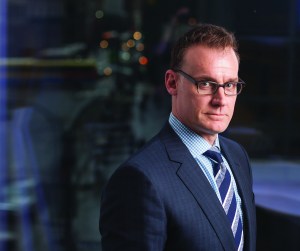JLL’s Peter Nicoletti Wants to Dominate the Middle Market … And Now
By Guelda Voien May 29, 2014 2:15 pm
reprints

Brokers are an ambitious lot, especially the most successful ones. Peter Nicoletti would count among those easily.
The 45-year-old broker who helms JLL’s rapidly expanding capital markets group has brokered some of the biggest and most complicated financings in New York City. And when it comes to ambition, he doesn’t mince words.
“The goal here is to be the top equity and debt provider in New York City,” he said of JLL at an interview in his Madison Avenue office last month. “It’s not a long-term plan.”
Still, he tempers his impulse to close a transaction—and nab a commission—with a grounded understanding of the needs of the other side of the deal. That may be a big part of why he and his team have set out on a meteoric rise through the city’s debt placement world.
When Jonathan Roth of Canyon Capital Realty Advisors approached Mr. Nicoletti in 2011, the Atlas portfolio, a group of nonperforming loans backed by 33 hospitality and industrial assets in 10 states, had very much caught his eye.
“We wanted the industrial portfolio very badly,” Mr. Roth said. Nonperforming loans were also Mr. Nicoletti’s specialty. After a respite selling industrial properties in New Jersey and a stint at MetLife, Mr. Nicoletti was tapped in 2010 to head the team that dealt with such loans at JLL in New York. He was straight with Mr. Roth.
“He indicated ‘you aren’t gonna win’ this deal,” Mr. Roth said. “But very quickly and without violating the rules of engagement, Pete said, ‘You should talk to so-and-so, and, collectively, you’d be a strong bid.’”
“So-and-so” ended up being Invesco and Square Mile Capital, and the trio, the result of deft matchmaking by Mr. Nicoletti, ended up buying the portfolio for $1.1 billion.
“We basically had a handshake deal to spend a billion dollars over the phone,” Mr. Roth said. But with the transaction under Mr. Nicoletti’s stewardship, he didn’t worry. “I didn’t lose one moment of sleep.”
Their relationship continued, as both moved past nonperforming loans, when distress in many markets dried up. Last year, Mr. Nicoletti helped recapitalize the Washington, D.C., Hilton, which Canyon owns, and now a JLL team is selling a retail project in Houston called the MarqE Mall for his firm, Mr. Roth said.
Of course, it would be easy to take Mr. Nicoletti at his word and believe that he is a “deal junkie.” He left a plum role at MetLife, who had secured him a $600-per-month apartment at Stuyvesant Town-Peter Cooper Village, to get back in the deal saddle, after all. And his type-A tendencies come out in almost everything he does. For instance, just a week before Mortgage Observer joined Mr. Nicoletti in his office at 330 Madison, he had joined Twitter. He urged us to follow him and to urge our colleagues to follow him, so he can meet his goal of doubling followers week over week.
He also recently ran a 10K race–but not in order to stay fit, which he is. Mr. Nicoletti ran the race because he was annoyed that last year’s winner of the annual race, which JLL brokers are encouraged to participate in, was a Canadian. He wanted to bring home the prize for the New York office. (He already coaches his son’s football team, who are state champions, and follows his own vigorous workout schedule. “You’ve got to in this industry,” he said. “The adrenaline will kill you if you don’t work out.”)
And while he technically won the 10K, he was disappointed to learn that this year’s race was turned into a “fun run,” where no times or winners or losers were recorded. He had trained for months, working to beat all of the other JLL brokers who competed. For the record, he won, he said.
But JLL wouldn’t entrust the debt business to someone unhinged by competitiveness—not now at least.
JLL CEO Jay Koster said the debt business is the company’s focus at the moment. Expanding the team, especially Mr. Nicoletti’s team in New York, is the firm’s main goal.
“You’ve seen us add to our retail, investment sales. … The business we’ve really been focused on has been this debt and equity component, which sort of glues them all together,” Mr. Koster said. And not only does debt and equity placement enable a deal—there is more financing to be done, period. “Sales of assets only happen once, on average, every five years,” he said. “The frequency with which people finance assets happens with three to five times greater velocity.”
One big reason why Mr. Nicoletti’s deal pacing is so attuned is that he has spent time on each side of the transaction. He started out selling, before moving to the ownership side at MetLife. After his four-year tenure with the life company ended, he had learned to temper his impulse to close any juicy deal that came across his desk.
“When I first got [to MetLife], I would be like, ‘We have to execute this transaction,’” he said. But then he “got to understand how clients saw a transaction—what their internal constraints might be, what the market is making them do.”
Mr. Nicoletti and Joe Garibaldi (who serves as his counterpart, managing tri-state area investment sales) later started their own firm called Garibaldi & Partners, which sourced debt and equity. But they opted to go back to a larger company in order to have broader access to capital.
“You are never the safe choice for institutional clients” as a new firm, Mr. Nicoletti said. “We ended up at HFF.”
The pair eventually departed HFF for JLL, also in tandem, in 2008.
And they’ve done well for themselves. Deal volume in the New York investment banking division has grown from $3 billion in 2011 to $4 billion last year, a representative for JLL said.
That growth is driven by deals like last year’s $100 million loan for the acquisition of 41 East 22nd Street, where Continuum Company Chairman Ian Bruce Eichner plans to build a nearly 800-foot tower. Hedge fund Davidson Kempner Capital Management provided the one-year bridge loan, which financed the buy and part of the pre-construction costs.
Now, Mr. Nicoletti is tasked with expanding the business, both in terms of personnel and scope.
He aims to double the size of his team in the next two years, to 24 or 25 debt producers. In New York, the hope is also to cut into the middle of the market, where stalwart Meridian Capital Group has dominated the market, and get in on the bread-and-butter deals for the midsize acquisitions that happen day in and day out across the five boroughs.
“We’ve always been in the mix on the larger deals, but we really want to make sure we are tackling the mid-market,” he said. He describes that space as loans from $25 million to $150 million. “It’s mostly dominated by the dozen New York-centric mortgage brokerage firms, the Meridians.”
Indeed, in April, JLL hired five brokers away from Meridian in one fell swoop, though Mr. Nicoletti is careful not to characterize the hires as “poaches.”
Moving forward, the hope is that JLL’s focus on its lending business can buoy the entire company.
“We’re trying to cover a very broad perspective,” said Mr. Koster. “$25 million [deals] all the way up to the largest and most complex transactions that occur in the city,” are their aim. The more established debt presence will help lubricate deals, the argument goes.
That philosophy proved correct in the recent disposition of 237 Park Avenue. Lehman Brothers sold the asset to a partnership between RXR Realty and Walton Street Capital for $810 million. The partnership assumed a $420 million securitized mortgage, and JLL arranged a $167 million mezzanine loan for the pair. The whopping sum for mezz was possible, because they were such qualified borrowers (not to speak of willing to pay the 7 percent interest-only rate). Impressed with the cut of JLL’s jib, the partnership tapped a JLL team to lease the property.
At the moment, JLL’s debt team has $8 billion to $10 billion in deals in its pipeline, a spokesperson said.
And what will the future bring? Mr. Nicoletti has a simple strategy for now: bringing what he calls “institutional quality execution” to the middle market.
“There is a large segment of that market to capture, and if we only get 10 to 20 percent of it, we will be well ahead of the game,” he said.


